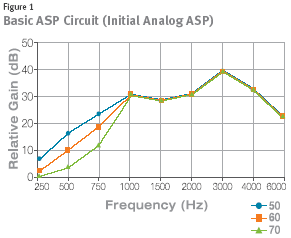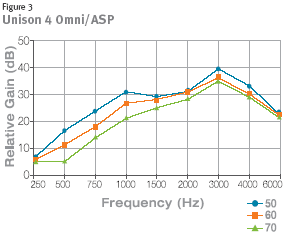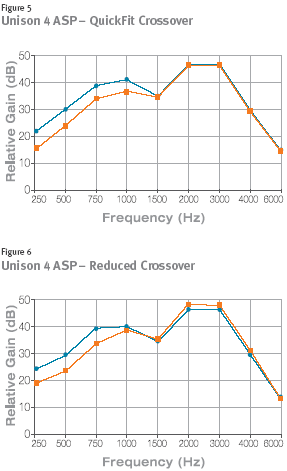View PDF Brochure
ASP Noise Suppression
Digital Advances in ASP Technology
Executive Summary
Automatic Signal Processing (ASP) has been available in analog hearing aids for more than 20 years. The primary objective of ASP is to improve the audibility and sound quality of quiet speech and reduce the upward spread of masking. Early versions of ASP had their limitations, primarily because they were used as a one-size-fits-all circuit for any listening situation and had a limited range of adjustment for bass increase in quiet. In short, they only worked for some people, in some situations. With the arrival of second generation ASP hearing aids, hearing healthcare professionals were able to fit a wider range of hearing losses, but because these were still primarily single-memory analog devices the one-size-fits-all problem continued. The advent of digital technology has made way for a new generation of ASP that eliminates the analog limitations. In Unitron Hearing's Unison 4, ASP is one of four available algorithms. This allows ASP to be used in noisier environments where it can provide the greatest benefit, while the other three algorithms can be used to optimize performance in different listening environments.
Early ASP Hearing Aids
Automatic Signal Processing (ASP) has been available in analog hearing aids since the 1980s. The main objective of ASP is to improve audibility for quiet speech and reduce the upward spread of masking. A more descriptive name for ASP is Bass Increase at Low Levels (BILL). By definition, BILL processing means that the low frequency gain of the hearing aid automatically increases as ncoming signals get softer. In other words, when the room is quiet, signal levels are low and more low frequency gain is applied by the hearing aid. As the signal levels in the room increase, the gain for low frequency sounds is automatically reduced.

Figure 1 shows how a low frequency noise (727 in flight) at three different input levels (50, 60 and 70 dBA) would have been processed by an early ASP hearing aid. This aid was designed to respond most effectively to low frequency sounds, however, any type of signal, including speech, could
have been used. You can see that the gain in the low frequencies is reduced as input level increases. Note, the clearly defined ASP high frequency transition point at 1000 Hz marks the upper limit of this gain reduction.
The Goals of ASP
The primary objective of ASP processing is to provide a wideband frequency response for soft or average levels of speech in quiet. The theory is that increasing low frequency amplification in quiet conditions (BILL) can improve the audibility and sound quality of the signal. This effect was shown by Moore, et. al. using a two-channel full dynamic range compression instrument. The secondary objective of ASP processing is to reduce the energy levels of background noise in the presence of speech. In this case, it is assumed that decreasing low frequency gain at higher input levels should reduce the upward spread of masking caused by intense low frequency noise.
ASP vs. WDRC
ASP should not be confused with Wide Dynamic Range Compression (WDRC), which is based on a different fitting philosophy. Granted, the primary objective of WDRC processing is the same as ASP processing: to provide maximum audibility for soft speech in quiet. However, the secondary objective of WDRC is to restore normal loudness perception of suprathreshold sounds.9 Therefore, the goal of WDRC in noise is to help maintain comfort rather than to eliminate upward spread of masking. Figure 2 illustrates how a wideband WDRC instrument would process the same jet noises as those shown in Figure 1. It is clear from the two
figures that ASP provides a more linear input/output function in the high frequencies than WDRC.

Limitations of Early ASP
ASP was initially used as a one-size-fits-all circuit with an automatically adjustable frequency response for any listening situation. For some people, this worked very well. Unfortunately, several researchers quickly demonstrated that the earliest ASP hearing aids were of limited value for most hearing aid wearers. This was because the early ASP circuits had a limited range of adjustment for bass increase in quiet. They also used a static ASP frequency transition point as shown at 1000 Hz in Figure 1.
Second generation ASP aids began appearing in the 1990s. These provided a greater range of bass increase in quiet, giving the practitioner the flexibility to fit a wider selection of hearing threshold configurations. They also employed adaptive high frequency transition points that changed automatically across a range of input levels. These products were
more favorably received by clinicians than the earlier models. Furthermore, some experiments began to show that ASP processing could at times be superior to linear amplification, particularly in the presence of low requency background noise. However, because ASP hearing aids were still predominantly analog, single-memory devices, only one processing strategy was possible for use in all environments. Whenever ASP is implemented in a single-memory analog device, there will always be flexibility issues and design limitations imposed by the one-size-fits-all approach.
Digital ASP Hearing Aids
A New Generation of ASP
Unitron Hearing's Unison 4 has eliminated the limitations of earlier analog ASP hearing aids. In Unison 4, ASP is one of four algorithms available in a flexible, multi-memory digital hearing aid. This means the ASP algorithm can now be used exclusively to improve performance in background noise. The presence of four-channel amplification, switchable directional microphones and three programmable memories eliminate the reliance on a one-size-fits-all processor. This allows the fitter to optimize the ASP algorithm exclusively for a given listening environment. Four-channel processing and directional microphones enable new levels of flexibility when
adjusting the ASP algorithm for such a situation. Meanwhile, the other two memories can be optimized using different algorithms for different listening situations. In other words, Unison 4 exploits the benefits of ASP processing in noise while overcoming the limitations of the analog, single memory approach by providing up to three other algorithms for different listening environments.
Unison 4 ASP Noise Suppression
Unison 4 provides a choice of four processing strategies - WDRC, Linear Limiting, Adaptive Compression, and ASP Noise Suppression - that can be programmed into any of three program memories. It is therefore not necessary, or even recommended, to use ASP processing to optimize speech audibility in quiet. Unison's four compression channels provide ample response shaping to optimize comfort and clarity in quiet for almost any hearing threshold configuration. The ASP algorithm can be set exclusively for noisier environments, where its automatic low frequency attenuation will provide the most benefit. In field trials, listeners with different hearing loss configurations demonstrated preferences for any one of several signal processing algorithms (WDRC, Linear Limiting or Adaptive Compression) in quiet, whereas, ASP Noise Suppression was the preferred processing choice for the majority of hearing losses in the presence of speech babble noise. An example of Unison's ASP algorithm, measured in omnidirectional mode, can be seen in Figure 3.

Note that, unlike early ASP devices with a fixed kneepoint, the kneepoint of low frequency attenuation in Unison 4 is adaptive. The kneepoint in Figure 3 rises from 1500 Hz to 3000 Hz as the noise changes from 50 dB to 70 dB. Therefore, not only does the amount of gain reduction adapt to
changes in the noise levels, so does the bandwidth over which that gain reduction occurs.

The amount of ASP gain reduction in the presence of noise can also be adjusted in Unison 4 using the ASP control in the Unifit fitting software. This control can be adjusted over a range of 30 dB. Turn the ASP control up for more automatic gain reduction, turn it down for less. This effect is demonstrated in Figure 4. Clients who have worn linear aids in the past or who have substantial hearing loss in the low frequencies may prefer less ASP effect than new users, previous WDRC wearers, or those with only a mild loss in the low frequencies.
Multi-Channel ASP

Because Unison 4 is a four-channel hearing aid with adjustable crossover frequencies, it is possible to alter the frequencies that serve as the ASP high frequency transition points. The performance of the ASP algorithm is active primarily in the two lower frequency channels. To a lesser extent, the third channel also contributes to ASP processing. When the crossover requencies between the channels are shifted, the bandwidths of the channels are changed. In this situation, the frequencies at which the ASP frequency transition points occur will likewise be shifted. In other words, when the F1 and F2 crossover controls in Unifit are shifted to lower frequencies, the ASP transition points will shift to lower frequencies as well. The reverse is also true. For an example of this effect, see Figures 5 and 6.
Fitting Features
As seen in Figure 3, the transition point changes as the incoming signal level changes. Because of this variability, it is not easy to predict the exact frequency of the ASP transition point for a given listening situation. However, two rules of thumb should be useful to clinicians regarding these
interactions:
- Increasing the ASP control in Unifit increases the amount of ASP gain reduction applied to any given signal. Decreasing the ASP control has the opposite effect.
- Shifting the crossover controls, particularly F1 and F2, to a higher frequency in Unifit shifts the ASP transition point to a higher frequency. This widens the frequency range over which the ASP gain reduction is effective.
In other words, if you don't think that the ASP algorithm is
reducing the low frequency gain enough for your client's needs in noisy environments, try increasing the ASP control. You may also increase the crossover controls (particularly F1 and F2) to extend the ASP effect further into the higher frequencies. Conversely, if you feel the ASP algorithm is
reducing the low frequency gain too much, decrease the ASP control setting. If it appears that the ASP is adversely affecting the audibility of higher frequency speech sounds, decrease the F1 and F2 crossover controls to restrict the attenuation to a lower range of frequencies.
ASP Noise Suppression and Directional Microphones
How is background noise affected when ASP Noise Suppression and directional microphone technology are combined in one hearing aid? When it comes to listening in background noise, the performance of directional microphone technology is well documented. However, the impact of combining directional microphones and ASP Noise Suppression is not intuitively obvious. To help shed some light on this combination, consider the example below:
- A speech signal and a low frequency noise (car engine) are both presented to the hearing aid simultaneously.
- The speech is always presented at 0° azimuth, or directly in front of the listener's head.
- The car noise is presented either at 0° (front) or 180° (back), representing noise from in front of or behind the listener.
- When the speech signal and the car noise emanate from the same direction, 0° azimuth, the ASP algorithm reduces low frequency gain as expected.
- When the speech signal and the car noise are spatially separated by 180° the output is determined by the microphone rather than the ASP algorithm. (The directional microphone reduces the level of the signal
from 180° azimuth before it reaches the ASP algorithm whereas the omni directional microphone does not.)
Observation: The low frequency gain is not further reduced by the ASP algorithm.
By combining the ASP Noise Suppression with vector directional microphone technology in Unison 4, low frequency background noise can be attenuated regardless of the location of the noise source. If the background noise is
behind the wearer the directional microphone reduces the level of the noise. However, in more diffuse noise settings, where low frequency noise is emanating from the front and/or all directions, the ASP circuitry controls the noise levels. The interaction between the ASP algorithm and the directional microphone varies depending on the levels, frequency content, location of noise sources and the ASP settings. However, their interaction provides optimum listening for the wearer in a variety of noisy conditions.
Summary
The primary objective of ASP is to improve the audibility and sound quality of quiet speech and reduce the upwardspread of masking. Early versions of ASP had their limitations because they had a limited range of adjustment for bassincrease in quiet and a fixed frequency transition point. The second generation of ASP circuits offered greater flexibility but they were limited to a single memory processing scheme. The advent of digital technology has made way for a new generation of ASP that eliminates the analog limitations. In Unitron Hearing's Unison 4, ASP is one of four available algorithms. This allows ASP to be used exclusively to improve performance in background noise, while the other three algorithms can be used to optimize performance in different listening environments. Far greater fitting flexibility is available than ever before and the vector directional microphone compliments the performance of ASP processing in most background noise situations.
Refer to PDF Brochure for Bibliography.
Authors
Don Hayes, PhD, Manager of Audiology, Research and Training
Nancy Tellier, M.Sc., Audiologist
Bill Christman, M.A., CCC-A, Manager of Audiology Research
Click here to visit the Unitron Hearing website.

